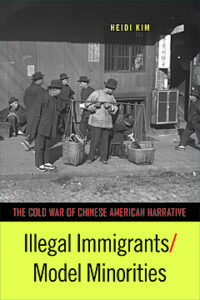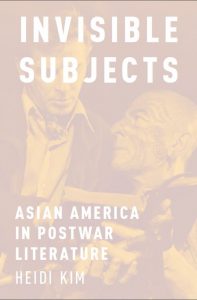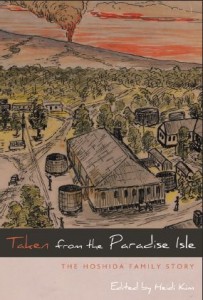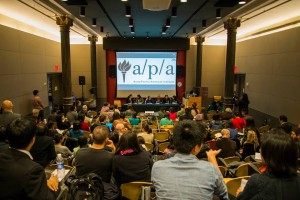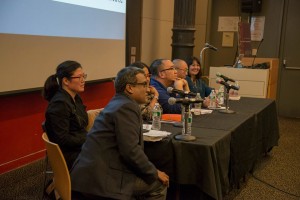This page lists books and selected articles I have published in the fields of literary criticism and American studies. To search by topic, please click on a tag in the right-hand column instead.
Books
Articles (partial list)
- Flower Drum Song and Immigration Policy
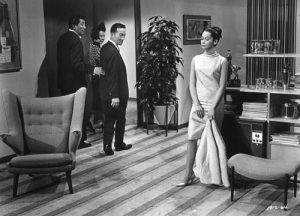 “Flower Drum Song, Operation Wetback, and Whitewashing: A Message from 1961″ by Heidi Kim appeared in the Los Angeles Review of Books in September 2016. Showcasing work from the Hammerstein papers in the Library of Congress, this article details how Hammerstein and his collaborator Joseph Fields slowly introduced the idea of illegal immigration into this otherwise light-hearted musical, which with its all Asian American cast, was a landmark in ethnic theater and film. This work forms part of Prof. Kim’s second book project, which will focus on the public discussion of illegal immigration in the Cold War.
“Flower Drum Song, Operation Wetback, and Whitewashing: A Message from 1961″ by Heidi Kim appeared in the Los Angeles Review of Books in September 2016. Showcasing work from the Hammerstein papers in the Library of Congress, this article details how Hammerstein and his collaborator Joseph Fields slowly introduced the idea of illegal immigration into this otherwise light-hearted musical, which with its all Asian American cast, was a landmark in ethnic theater and film. This work forms part of Prof. Kim’s second book project, which will focus on the public discussion of illegal immigration in the Cold War.Share: http://tinyurl.com/FDS1961
- The Budapest Quartet and Jade Snow Wong: BFFs?
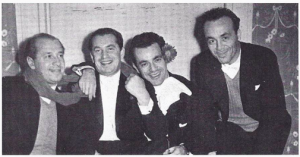 “Artist to Artist, Across the Years: Jade Snow Wong and the Budapest Quartet” by Heidi Kim appeared in the Library of Congress’s online feature In the Muse in January 2016. It begins, “One of the most engaging and charming anecdotes in Jade Snow Wong’s memoir Fifth Chinese Daughter, a bestseller of the 1950s, recounts how she, as a student at Mills College, cooked a Chinese dinner for a famous string quartet who her dean was hosting.” Kim goes on to detail how she found, in Wong’s archives at the Library, a charming story of a friendship that lasted for many years between the young woman who became a famous artist herself and a world-famous quartet.
“Artist to Artist, Across the Years: Jade Snow Wong and the Budapest Quartet” by Heidi Kim appeared in the Library of Congress’s online feature In the Muse in January 2016. It begins, “One of the most engaging and charming anecdotes in Jade Snow Wong’s memoir Fifth Chinese Daughter, a bestseller of the 1950s, recounts how she, as a student at Mills College, cooked a Chinese dinner for a famous string quartet who her dean was hosting.” Kim goes on to detail how she found, in Wong’s archives at the Library, a charming story of a friendship that lasted for many years between the young woman who became a famous artist herself and a world-famous quartet. - Twelve Years a Slave
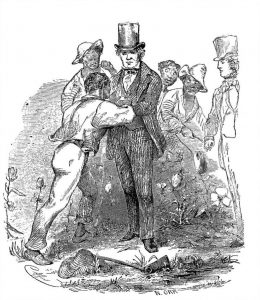 “How Twelve Years a Slave was Made, 150 years before 12 Years a Slave” was published in 2014 in the Los Angeles Review of Books. Looking at the literary history of the original publication of Solomon Northrup’s memoir, Prof. Kim explores the complicated politics of publishing a slavery narrative for a largely white audience.
“How Twelve Years a Slave was Made, 150 years before 12 Years a Slave” was published in 2014 in the Los Angeles Review of Books. Looking at the literary history of the original publication of Solomon Northrup’s memoir, Prof. Kim explores the complicated politics of publishing a slavery narrative for a largely white audience. - The Grapes of Wrath at 75
I wrote a piece for the Ethos Review, recently founded here at UNC, on the significance of John Steinbeck’s Grapes of Wrath, which was published 75 years ago.
- Incarceration, Cafeteria Style
 Heidi Kim’s essay “Incarceration, Cafeteria Style,” about the politics of proper eating during the Japanese American incarceration, appears in the first ever Asian American food studies reader, Eating Asian America, released in fall 2013 from NYU Press. See the book’s Amazon page here.
Heidi Kim’s essay “Incarceration, Cafeteria Style,” about the politics of proper eating during the Japanese American incarceration, appears in the first ever Asian American food studies reader, Eating Asian America, released in fall 2013 from NYU Press. See the book’s Amazon page here.The A/P/A Institute at NYU hosted a wonderful book launch for us which was attended by well over 100 people. Chaired by Krishnendu Ray (NYU), the book’s three editors and three of the authors, including me, presented snippets of the essays and discussed the book’s overall motivation and contribution.
Below are some pictures from the event. Thanks to the A/P/A Institute at NYU for the photos.
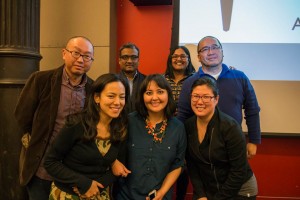
Top row: Robert Ku, Krishnendu Ray, Anita Mannur, Martin Manalansan IV.
Bottom row: Nina Fallenbaum Ichikawa, Zohra Saed, Heidi Kim. - Steinbeck’s ideal woman
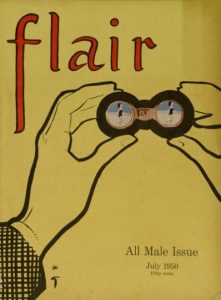 My post on a little gem of a Steinbeck finding at the UT Austin Harry Ransom Center (a true treasure trove of literary materials) is up here.
My post on a little gem of a Steinbeck finding at the UT Austin Harry Ransom Center (a true treasure trove of literary materials) is up here.As with so many male authors of the period, Steinbeck’s depiction of women has often been critiqued. Here, he encapsulates his views on women to the point of self-caricature. Flair was a short-lived, very high-art magazine which had a well received run in the 1950s.
- Whitman’s Identity at War: The Wound-Dresser
My article on the reception and performance history of John Adams’ song setting of “The Wound-Dresser” (a great piece for baritone and small orchestra) is out from my friends at the WWQR. Thanks to editor Ed Folsom for his enduring support of Whitman and young Whitman scholars!
This was a particularly fun article for me to write (and a horrific bibliographical experience). It was a first venture into writing about one of my big hobbies, classical music, and I got to use an almost overwhelming variety of sources, including interviews I conducted with two tremendous opera singers, Nathan Gunn and Eric Owens. I also drew on baritone Thomas Hampson‘s considerable public speaking about this piece, thanks to the New York Philharmonic media staffer Katie Klenn, who really went the extra mile in shipping me DVDs of his talks.
The only thing I didn’t try to do was interview Adams, and now, as I look at the piece, I can’t think for the life of me why not. I did use his blog.
Link here (subscription/pay required).
Citation: Kim, Heidi Kathleen. “Whitman’s Identity at War: Contexts and Reception of John Adams’ The Wound-Dresser.” Walt Whitman Quarterly Review 30 (2013), 78-92.
- Fred Korematsu
Just out! “When You Can’t Tell Your Friends from the Japs: Reading the body in the Korematsu case.” Journal of Transnational American Studies special issue in honor of Sau-ling Cynthia Wong, spring-summer 2012 (4(1)).
Fred Korematsu, plaintiff of the landmark 1944 case Korematsu v. United States, famously had cosmetic surgery on his face to try to escape the ‘internment,’ the mass incarceration of Japanese Americans during World War II. This article examines the popular and legal discussion of his surgery at that time, which show that fears of Japanese spies and the supposed inability to distinguish Japanese, captured in the famous Life magazine article “How To Tell Your Friends from the Japs,” directly influenced the courts’ rulings on the legality of the internment. The deliberate decision of the Supreme Court to excise this issue from the Korematsu opinion, which disclaimed racism as a root cause of the internment, is exposed through archival documents and drafts that betray a deep interest in his surgery, as do the government and lower court documents. As a heroic figurehead of civil rights, Korematsu complicates the discussion of surgical patients as complicit, drawing attention instead to the legalized discrimination that drives such choices. Likewise, key Supreme Court cases benefit from a close reading of the issue of mutable appearance and racial passing, as they show a common anxiety and inability to define race precisely on the body.
The issue is available for free online.
I was delighted to be able to participate in an issue to honor Sau-ling Wong and her many contributions to the field of Asian American studies. In particular, her idea of “food pornography” is always a hit with students!
- Faulkner and the Mississippi Chinese
“The Foreigner in Yoknapatawpha: Rethinking race in the global South” was published in a Philological Quarterly special issue: The New Southern Studies and the New Modernist Studies in Spring & Summer 2012 (90(2&3): 199-228).
Though it’s not a well-known fact, there was a small but very visible Chinese minority in Mississippi throughout the years of Faulkner’s active writing career, and one that came to national fame in a Supreme Court case about whether they should be put in white or black public schools. When Joe Christmas first arrives in Jefferson in Light in August, a sulky, light-colored man with no money and city clothing, the townsfolk label him a “foreigner.” His name and indefinable appearance allow him to exist in an undefined limbo between black and white until he transgresses social boundaries in both directions, unlike the lone Chinese man in The Town and the Chinese population in real life. Starting with the definition of foreignness in Light in August and reading through Intruder in the Dust (1948) and The Town (1957), I examine the role of the the Chinese as the most visible exponents of the foreign as a new party in Faulkner’s tortured generations of Southern history, comparing his surprisingly elastic social structures with the contemporaneous restrictions on the growing Chinese population in legal and social arenas. Gong Lum v. Rice (1927), the landmark Supreme Court case that turned away from the singular consideration of African Americans as the “colored race” to define the Chinese as one of the “colored races” resonates with the white supremacist in Light who asserts superiority over “any and all other races.” Ike McCaslin, one of Faulkner’s characters, voices hatred of the “spawning” and “breeding” Chinese, among other races, but even Faulkner’s extension of racial hysteria over miscegenation to include the Chinese who were moving into the Delta offers, as well, the possibility of eventual social intermixture and inclusion in his American South.
This article won PQ‘s annual Hardin Craig Prize for the article that has best advanced scholarship in its field.
Link here (requires Chadwyck subscription).
- A Francophone antislavery epic
“The Francophone Uncle Tom’s Cabin” was published in the Little-Known Documents section of PMLA (Proceedings of the Modern Language Association) in May 2010 (125(3):798-815).
Charles Testut, a French-born Creole radical publisher and writer, wrote an epic novel detailing the adventures and eventual triumph of a married couple of Guadeloupean slaves illegally sold to the United States. It bears clear resemblances to Harriet Beecher Stowe’s Uncle Tom’s Cabin, but with Testut’s politics and his heavy French Romantic influence (by writers such as Alexandre Dumas), it is much more violent, sexual, and openly political a novel, with several diatribes against Catholic zealots, Louisiana judicial corruption, and racial prejudice. Though it was written before the Civil War, Testut was only able to publish the novel in 1872.
Article link here (requires subscription or pay per article). More information and an excerpt are available here.
- Walt Whitman and Anglo-Saxonism
My article “From Language to Empire: Walt Whitman in the Context of Popular Nineteenth-Century Anglo-Saxonism” was published in the Walt Whitman Quarterly Review in the Summer 2006 issue (24(1):1-19).
This article contextualizes Walt Whitman’s invocations of Anglo-Saxon culture and its uneasy connections to white supremacist writing by comparing his words to those of many popular magazines and newspapers dealing with the subject, from editorials in the most prominent newspapers to specialist magazine The Anglo-Saxon. The slippery slope from the cherishing of Anglo-Saxon words and literature to the racialist or imperialist ambitions of England and the United States can be traced in both Whitman and the other work, but Whitman’s emphasis on diversity and the freedom of the individual takes his Anglo-Saxonism in a new and unexpected direction.
Link to article here.
